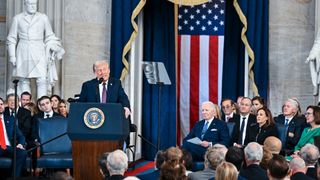'We will pursue our manifest destiny into the stars.' President Trump wants astronauts to raise the American flag on Mars
"Americans are explorers, builders, innovators, entrepreneurs and pioneers. The spirit of the frontier is written into our hearts," Trump says.
President Donald Trump wants to lead the United States to Mars.
After taking the oath of office to be sworn in as the 47th U.S. president on Monday (Dec. 20), Trump laid out his vision for the next four years in an inauguration speech that called for a return to American expansionism and exploration.
"My message to Americans today is that it is time for us to once again act with courage, vigor and the vitality of history's greatest civilization," Trump said during his speech inside the Capitol rotunda. "The United States will once again consider itself a growing nation, one that increases our wealth, expands our territory, builds our cities, raises our expectations and carries our flag into new and beautiful horizons. And we will pursue our manifest destiny into the stars, launching American astronauts to plant the stars and stripes on the planet Mars."

A philosophy of manifest destiny in the 19th century drove the American expansion across North America to settle what is now the United States. Trump's comment takes that concept and aims it into space.
"There's no nation like our nation," Trump said. "Americans are explorers, builders, innovators, entrepreneurs and pioneers. The spirit of the frontier is written into our hearts. The call of the next great adventure resounds from within our souls."
Related: Presidential Visions for Space Exploration

SpaceX CEO Elon Musk, who attended the inauguration, gave a huge smile and thumb's up in reaction to Trump's Mars comment. Musk has long said his goal with SpaceX is to send humans to Mars in a bid to make humanity a multi-planet species.
Get the Space.com Newsletter
Breaking space news, the latest updates on rocket launches, skywatching events and more!
To that end, SpaceX has launched seven test flights so far of its massive Starship rocket, the world's largest and most powerful launch vehicle, the most recent of which occurred on Jan. 16. That Flight 7 test flight included the successful landing and capture of the Starship's huge Super Heavy booster, but the Starsip vehicle exploded during ascent. An FAA investigation into the anomaly is underway.
NASA has picked SpaceX's Starship to land its Artemis astronauts on the moon on the Artemis 3 mission no earlier than 2027, after years of delay. Musk has said SpaceX could attempt to launch its first uncrewed Starship to Mars in 2026.
Billionaire Jeff Bezos, founder of the private space company Blue Origin, also attended Trump's inauguration just days after Blue Origin successfully launched its own huge new rocket, called New Glenn, into orbit for the first time. NASA has tapped New Glenn to launch its next robotic mission to Mars, a double spacecraft mission called ESCAPADE.
Trump's inuaguration on Sunday marked his return to Oval Office after being elected as the 45th U.S. president in 2016. In 2020, Trump lost reelection to now former President Joe Biden.
In his speech, Trump pledged a sweeping rollback of Biden policies in his first days in office, including declaring a national emergency at the country's border to curb illegal immigration and measures targeted at transgender rights, among others. Trump, who was convicted of 34 felony counts related to falsifying records during his first campaign, is the first felon to serve as U.S. president.
During his first administration from 2017 to 2021, Trump gave substantial support to U.S. space security and exploration. He founded the U.S. Space Force as a new branch of the military to safeguard U.S. interests in space.
Trump also resurrected the National Space Council, led by then-Vice President Mike Pence, to push NASA and other U.S. space projects forward. The Biden administration continued the National Space Council under the leadership of then Vice President Kamala Harris, who attended NASA's first attempt to launch its first Space Launch System megarocket to the moon during the Artemis 1 mission in August 2022.
Trump's current Vice President J.D. Vance, who was also sworn in on Sunday, is now expected to lead the National Space Council, should the new Trump administration keep it going.
Trump has tapped billionaire Jared Isaacman, who has flown to space twice on SpaceX rockets on missions he personally bankrolled, as his nomination for the next NASA Administration. The agency's current chief Bill Nelson, a former Florida senator, announced his retirement Monday.
"Thank you to the NASA family, who embodies the can-do spirit that makes our country exceptional. It has been the honor of my life to stand and serve with you," Nelson wrote in a statement on X. "As I leave public office today after 53 years, thank you for the great privilege of a lifetime of serving the people of our country. I am humbled and grateful," he added.
Trump said he hopes the next four years will mark a turning point for the American people.
"We will live proudly, we will dream boldly, and nothing will stand in our way, because we are Americans," Trump said. "The future is ours, and our Golden Age has just begun."
Join our Space Forums to keep talking space on the latest missions, night sky and more! And if you have a news tip, correction or comment, let us know at: community@space.com.

Tariq is the Editor-in-Chief of Space.com and joined the team in 2001, first as an intern and staff writer, and later as an editor. He covers human spaceflight, exploration and space science, as well as skywatching and entertainment. He became Space.com's Managing Editor in 2009 and Editor-in-Chief in 2019. Before joining Space.com, Tariq was a staff reporter for The Los Angeles Times covering education and city beats in La Habra, Fullerton and Huntington Beach. In October 2022, Tariq received the Harry Kolcum Award for excellence in space reporting from the National Space Club Florida Committee. He is also an Eagle Scout (yes, he has the Space Exploration merit badge) and went to Space Camp four times as a kid and a fifth time as an adult. He has journalism degrees from the University of Southern California and New York University. You can find Tariq at Space.com and as the co-host to the This Week In Space podcast with space historian Rod Pyle on the TWiT network. To see his latest project, you can follow Tariq on Twitter @tariqjmalik.
-
George² Should be have not enough time in one mandate to touch stars. But for Mars flagged, again, yes. If I remember good first flags landed on Mars with Viking lander 1?Reply -
contrarian It is on the Phoenix lander also :Reply
https://science.nasa.gov/resource/phoenix-and-the-american-flag-on-mars/ -
AboveAndBeyond Shoudn't he have said "to the stars", not "into the stars"?Reply
(Set the controls for the heart of the Sun...)
I know he was speaking symbolically, as politicians are apt to do, but it also could have been planets not stars, to be precise.
The hitch is that a mission there and back takes about 3 years, so there's no way that's going to happen during his term. -
Squid Correction: elon musk whispering into trumps ear while pulling his puppet strings wants astronauts to raise the flag on Mars.Reply